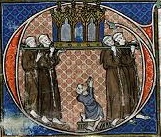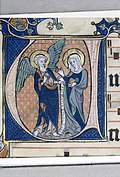Johannes of Valkenburg
Johannes von Valkenburg was a Franciscan minor in Cologne, a calligrapher and illuminator as well as the author of a gradual that was completed in 1299. Von Valkenburg made two copies, one is in the Archbishop's Diocesan and Cathedral Library in Cologne , the other in the University and State Library in Bonn.
The author
Von Valkenburg probably comes from the place Valkenburg aan de Geul , which is located in the south of the Dutch province of Limburg . Apart from the authorship of the graduals, little is known about him. His portrait, name and confirmation of authorship can be found on the title pages of the two manuscripts.
style
The two manuscripts are dated and were completed in 1299. They were most likely made for use in a Franciscan convent . At the time of their creation, a large number of Brabant convents belonged to the province of Cologne, including a monastery in Maastricht.
The graduals each consist of 22 miniatures including the title pages. With one exception, they are all made by a single person. Both works are characterized by a high degree of sophistication, although the gradual in Cologne has even more decorations than the one in Bonn. Characteristic of the style of Frater Johannes are small, slender figures that stand out against the gold-colored, ornamental background, round and bulging folds, as well as strong, glazed colors. The two manuscripts are particularly important because they are the first in a series of important liturgical books in a style characteristic of the Cologne painter's workshops, which were written in the first half of the 14th century. Johannes von Valkenburg probably took Maasland art , as can be found in older Cologne manuscripts (such as the manuscripts MS 41 and 111, which were created around 1280 and which are now in the Walters Art Museum in Baltimore) as a model for his style. These had also been created for the Franciscans and were influenced by Maasland manuscripts. Contemporary church windows can also be seen in his works.
For the decoration of his liturgical books, Fr. Johannes developed a uniform system which he consistently implemented. In his motifs one can recognize the Parisian models from the middle of the 13th century, which had been conveyed through the Maasland book illumination. Fr. Johannes prefers the radial arrangement of angular branches around the initials that encompass the text and carry drolleries and all kinds of birds, animals or figures. At the ends of these initial runners there are small golden balls (engrêlé) , a motif that could have been taken from heraldry. Two works are considered to be possible direct models for the two graduals of Fr. Johannes: the Psalter of Reuschenberg was made in the Diocese of Liège and is now in private hands, another illuminated psalter by a Liège painter is under Dom Hs.260 in the Archbishopric Cathedral library preserved. They show the same preference for engrêlé trimmings.
The ornate initials are often crowned with multilevel and gilded eyelashes with three-ray and fitting shapes. There are strong similarities between the miniatures of the gradual and the church windows of the Dominican cruciform church, which were made after 1280. Standing figure tabernacles as they are typical for the Valkenburg Gradual, came here in the Cologne glass painting. The initials are also likely to incorporate architectural motifs from the construction phases of the Cologne Cathedral under Master Arnold . The updating of the illumination motifs in Cologne ran at the same time to similar tendencies in Paris, where new ornamental forms in the architecture of the north transept of Notre-Dame flowed into the miniatures. The Valkenburg Gradual is thus a synthesis of French-Maasland style influences found and assimilated in Cologne itself.
The Valkenburg Gradual in Cologne
The gradual
The Gradual of Cologne, Codex 1001b of the Diocesan Library of Cologne (usually called the Valkenburg Gradual ) consists of 321 individual sheets of parchment measuring 44.5 cm × 31 cm . It was restored by Johannes Sievers in 1972. In his report enclosed with the manuscript, the latter reports that the work was in very poor condition. The whole book had all the symptoms of centuries of extensive use. The sides were covered by tough, brown-black dirt caused by hand perspiration, partly as thick as a knife, under which the decorations had partly disappeared.
On the full-page entrance miniature (sheet 1v), the Franciscan Minorite Johannes von Valkenburg is shown kneeling in a portal-like architectural brochure. He is thereby of the hll. Clare and Bonaventure flanked, above that Christ is enthroned next to Mary and St. Francis of Assisi . John points with his hand at a board with an inscription that identifies him as the author of the text, the notes of the chant and also as the illuminator of the manuscript. It gives the year 1299 as the year of completion: Ego frater Johannes de Valkenburg scripsi et notavi et illuminavi istud graduale et complevi anno Domini millesimo ducentesimo LXXXX nono .
Ornate initials
The edges are often decorated with drolleries , animal or plant motifs, birds or zoomorphic figures. Issues that can also be found in manuscripts from Paris, such as the hunting dogs, the hares, the winged dragons that wind around branches or hide in buds, and the hunters who shoot an arrow at an animal from the middle of a book page, are strikingly common . According to the fashion prevailing in Paris at the time, the initials only take up a third of the width of the page, but are generally surrounded by a square frame. The backgrounds are patterned. The motifs are shown in vivid colors, especially blue, green, violet, gray, beige and white, but only a little gold leaf is used. The initials have the following motifs:
- King David kneels before Christ
- Birth of Christ
- Epiphany
- Resurrection of Christ
- Ascension of Christ
- Descent of the Holy Spirit
- Calling of hll. Peter and Andrew
- Offering in the temple
- Annunciation
- the St. Anthony of Padua
- the St. John the Baptist
- the hll. Peter and Paul
- the martyrdom of St. Laurentius
- the death of Mary
- the birth of Mary
- The Archangel Michael kills the dragon
- Relic procession
- The coronation of Mary in heaven
- King David in front of an olive tree
- Altar consecration
- Requiem for a deceased confrere
- Graduals of Cologne
The Gradual of Bonn
In the same year Valkenburg created another gradual in which an inscription indicates his authorship. It is under the signature S 384 in the University and State Library of Bonn. It is listed there under Graduale des Johannes von Valkenburg . It consists of 316 parchments in the format 41.5 × 29 cm.
The text of the Bonn gradual is identical to that of the Cologne copy. The miniatures differ only slightly. The choice of motifs for the miniatures suggests that they were used in Franciscan monasteries. A special feature is the initial to the Introitus G (audeamus omnes) : it shows the iconographically rarely documented miraculous healing of a lame person during the translation of the relics of the saint, probably inspired by the first Vita of St. Francis written by Thomas von Celano .
- Graduals from Bonn
Other manuscripts
Some pages in manuscripts are attributed to the environment or the successors of Valkenburg:
- a depiction of the Coronation of Mary, now in the National Gallery of Art .
- a depiction of the Ascension of St. Dominic, now in the Art Institute of Chicago .
Individual evidence
- ↑ Langkatalogisat, Cologne Cathedral Library: Codex 1001b. and Codex 1001b. at ceec.uni-koeln.de.
- ↑ See: Picture gallery → Selected images from manuscripts in the Diocesan and Cathedral Library Cologne → Diözesan Hs. 1b. on dombibliothek-koeln.de.
- ^ Bonn University Library, p 384.
- ^ Diocesan manuscript 1b, Graduale des Johannes von Valkenburg. ( Memento of the original from January 28, 2016 in the Internet Archive ) Info: The archive link was inserted automatically and has not yet been checked. Please check the original and archive link according to the instructions and then remove this notice. on dombibliothek-koeln.de.
- ↑ a b c d e Markus Müller: Graduals of Johannes von Valkenburg. Catalog book for the exhibition. In: Joachim M. Plotzek, Ulrike Surmann (Hrsg.): Belief and knowledge in the Middle Ages. Hirmer, Munich 1998, ISBN 978-3-7774-7910-1 , pp. 423-426, ( ceec.uni-koeln.de ).
- ↑ W.41: Cologne Psalter-Hours. on thedigitalwalters.org.
- ↑ W.111: Franciscan Liturgical Psalter. on thedigitalwalters.org.
- ^ Johannes von Valkenburg. In: Colum Hourihane: The Grove Encyclopedia of Medieval Art and Architecture. Volume 2, Oxford University Press, 2012, ISBN 978-0-19-539536-5 , pp. 527-528.
- ^ Judith Oliver: Psalter. Catalog book for the exhibition. In: Joachim M. Plotzek, Ulrike Surmann (Hrsg.): Belief and knowledge in the Middle Ages. Hirmer, Munich 1998, ISBN 978-3-7774-7910-1 , pp. 419-421, ( ceec.uni-koeln.de ).
- ^ Judith Oliver: The Mosan origins of Johannes von Valke. In memoriam of Robert Branner. In: Wallraf-Richartz-Jahrbuch. Volume 40, 1978, pp. 23-37.
- ^ Judith Oliver: The french gothic style in Cologne. Manuscripts before Johannes von Valkenburg. In: Miscellanea Neerlandica. Volume 1, Peeters, Louvain 1987, pp. 381-396, ISBN 978-90-6831-078-8 .
- ^ A b Günter Gattermann (ed.), Heinz Finger: Graduale des Johannes von Valkenburg. In: Rhineland manuscript census. Heinrich Heine University, 1993, accessed January 22, 2016, pp. 144 and 711.
- ↑ Johannes Sievers: Restoration. April 24, 1972.
- ↑ The dedication text is easier to read in the Bonn Gradual.
- ↑ Jean Wirth, Isabelle Engammare: Les marges à drôleries des manuscrits gothiques, 1250-1350. Librairie Droz, Geneva 2008, ISBN 978-2-600-01231-7 .
- ↑ Danielle Gaborit Chopin: L'art au temps des Rois maudits. Philippe le Bel et ses fils, 1285-1328. Réunion des Musées Nationaux, Paris 1998. OCLC 468214512 .
- ↑ 3r .
- ↑ 20r .
- ↑ 27v .
- ↑ 144r .
- ↑ 161r .
- ↑ 165r .
- ↑ 198r .
- ↑ 203r .
- ↑ 210v .
- ↑ 215v .
- ↑ 217v .
- ↑ 220v .
- ↑ 224r .
- ↑ 225v .
- ↑ 227r .
- ↑ 230r .
- ↑ 232v .
- ↑ 234r .
- ↑ 236r .
- ↑ 290r .
- ↑ 292 .
- ^ The Coronation of Mary
- ↑ Ascension of St. Dominic
| personal data | |
|---|---|
| SURNAME | Valkenburg, Johannes von |
| BRIEF DESCRIPTION | Book and miniature painter |
| DATE OF BIRTH | 13th Century |
| DATE OF DEATH | after 1299 |




















